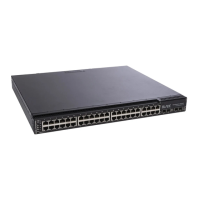266 RackSwitch G8000: Application Guide
Virtual Links
Usually, all areas in an OSPF AS are physically connected to the backbone. In some
cases where this is not possible, you can use a virtual link. Virtual links are created
to connect one area to the backbone through another non-backbone area (see
Figure 26 on page 258).
The area which contains a virtual link must be a transit area and have full routing
information. Virtual links cannot be configured inside a stub area or NSSA. The area
type must be defined as
transit
using the following command:
The virtual link must be configured on the routing devices at each endpoint of the
virtual link, though they may traverse multiple routing devices. To configure a G8000
as one endpoint of a virtual link, use the following command:
where
<link number>
is a value between 1 and 3,
<area index>
is the OSPF area
index of the transit area, and
<router ID>
is the IP address of the virtual neighbor,
the routing device at the target endpoint. Another router ID is needed when
configuring a virtual link in the other direction. To provide the G8000 with a router ID,
see the following section Router ID.
For a detailed configuration example on Virtual Links, see “Example 2: Virtual Links”
on page 273.
Router ID
Routing devices in OSPF areas are identified by a router ID. The router ID is
expressed in IP address format. The IP address of the router ID is not required to be
included in any IP interface range or in any OSPF area, and may even use the
G8000 loopback interface.
The router ID can be configured in one of the following two ways:
• Dynamically—OSPF protocol configures the lowest IP interface IP address as
the router ID (loopback interface has priority over the IP interface). This is the
default.
• Statically—Use the following command to manually configure the router ID:
If there is a loopback interface, its IP address is always preferred as the router
ID, instead of an IP interface address. The
ip
router-id
command is the
preferred method to set the router ID and it is always used in preference to the
other methods.
• To modify the router ID from static to dynamic, set the router ID to 0.0.0.0, save
the configuration, and reboot the G8000.
• To view the router ID, use the following command:
RS G8000(config-router-ospf)# area <area index> type transit
RS G8000(config-router-ospf)# area-virtual-link <link number>
neighbor-router <router ID>
RS G8000(config-router-ospf)# ip router-id <IPv4 address>
RS G8000(config-router-ospf)# show ip ospf

